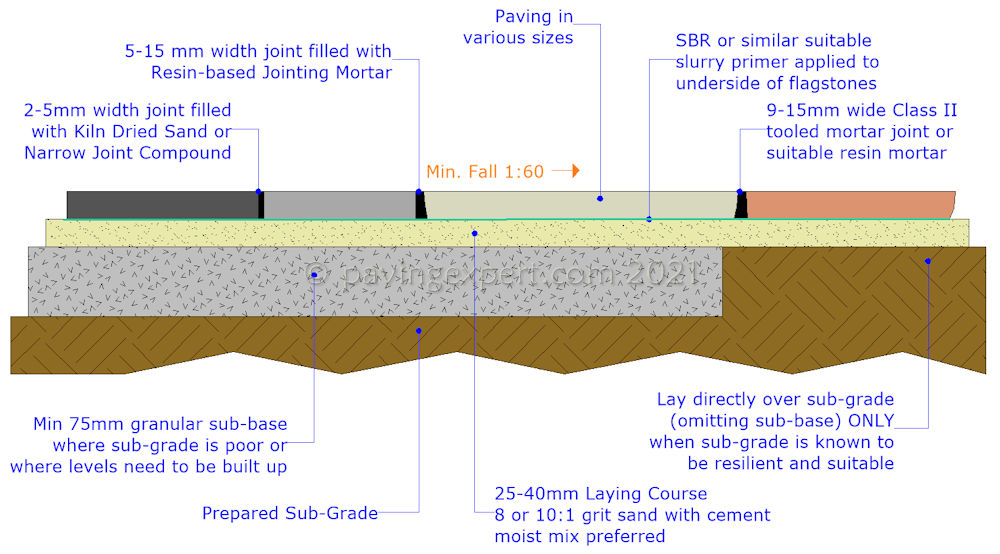Uses and Types
Terminology
Another example of regional terminology. In NW England, they are referred to as 'Flags', in other parts they are known as 'Slabs'. Both terms refer to exactly the same item, that is, sections of pre-cast concrete, normally rectangular in plan but also available in other geometric shapes. The term 'flag' will be used in the remainder of this page, which deals with those flags designed to be used for lightweight applications, such as patios, garden paths and the like.
The thicker, heavier, stronger BS flags used for public areas and footpaths are dealt with on a separate page, as are stone flags and the various methods of laying . There is also a separate page which considers flags used for paving driveways .
Types and Groups of Flags/Slabs
There are three types of materials commonly used for patio flags:
Follow the links for further expanation of each type.
There are pros and cons to each, but between them, they provide such a phenomenally wide range of choice that it's almost impossible not to find something that appeals!
As will be explained below, patio flags can be categorised into three main groups; Riven, Textured or Decorative. The principles involved in laying each type are basically the same, although the exact nature of the flag will determine how they may be jointed, mortar pointing , polymeric jointing or dry sand jointing being the most popular methods.
Widely used for paths and patios, these flags are designed to be 'different', but attractive, and when chosen correctly, will enhance any type or age of property. Many are not suitable for vehicular traffic although some of the better quality products will be satisfactory when laid on a full concrete bed .
Riven-effect Paving
Riven-effect is the name given to those patio flags manufactured from cast concrete that mimic the appearance of the traditional old stone flags. There is a vast range available, and an equally massive range of quality to suit, from cheap'n'cheerful 99p budget flags sold by the DIY chains, to top quality, highly accurate copies that can easily pass as genuine stone to the untrained eye. The better quality ranges come in a wide selection of plan sizes to enable traditional random layouts to be laid - refer to Random Layouts page for more information.
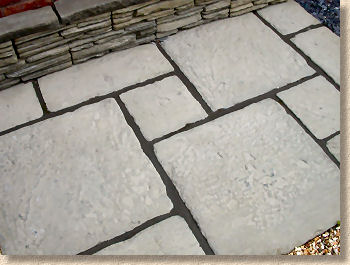
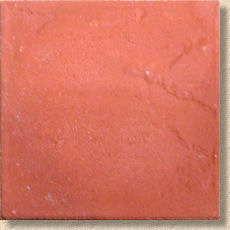
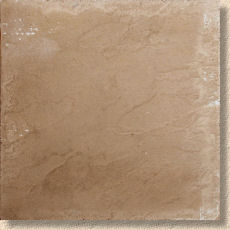
While the budget flags, such as these shown opposite, have their uses, they really aren't very authentic. They are often knocked out by the DIY sheds with amazing claims that "you too can build this stunning patio for under £100". If you're looking for realism, you're going to have to pay a lot more!
Generally speaking, you get what you pay for with all of these riven flags. The cheap'n'cheerful usually have a low cement content, are worryingly thin, down to 20mm in some examples, and with poor dyes that fade in UV light. They also tend to come in just one size, 450x450mm.
The quality products from the big manufacturers tend to have better dyes, a higher cement content, and are generally that bit thicker. To emphasise the quality, they usually come in a wider range of sizes, often based on a 150mm module, so pattern formulation is fairly straightforward.
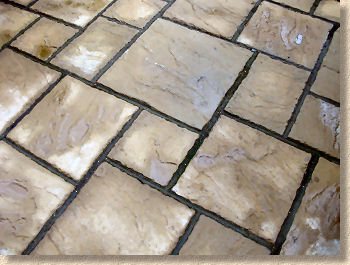
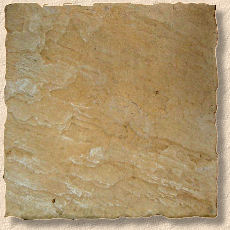
Give some thought to the surface of these flags. While some have a reasonably smooth finish, others are exceptionally 'bumpy', making them difficult for those unsteady on their feet, young children in pedal cars and the like, and, in some cases, it can be almost impossible to stop the patio table from rocking.
Obviously, the aesthetics will often drive the choice of flagstone, and while heavily textured riven effect paving might seem to be the ideal choice for a country cottage, the amenity or useability of the flags should be considered. Back in Ye Olden Dayes the property owners didn't choose rough textured flagstones because they looked pretty: they were chosen because there was nothing else!
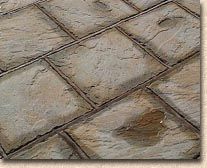

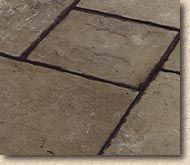
Most riven flags require mortar joints ; dry sand joints will not hold them in place, as the uneven edges of these units leads to variable joint widths, nearly always in excess of 10mm.
Some of the cheaper units have 'square' edges (arisses) that are smooth and obviously manufactured, whereas the more expensive types tend to have 'fettled' edges, that is, the edges have the rough riven appearance of the surface.
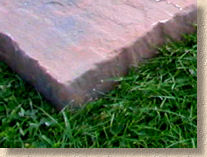

If you are planning to use this type of flag in a situation where the edge(s) may be exposed, such as the treads for steps , then make sure you are happy with the appearance of the edge before buying.
Textured Paving
Textured flags are those with a surface that has been altered in some way. These include a coarse textured finish, the smooth ground or polished types, and the exposed aggregate ranges. Most of these types of flags are manufactured by wet-press methods, rather than casting in a mould as the rivens and decoratives tend to be, and we generally find them to be somewhat stronger.
There is a good range of shapes, sizes and colours available to suit every application. The exposed aggregate flags can look stunning when used sympathetically with the immediate area, and the smooth ground types are our personal favourite. We find that the coarse textured flags very rapidly become a haven for mosses and lichens in untrafficked, shady spots although they sometimes can be successfully cleaned with a power washer , if the jointing is sound and the paving is competent and intact.
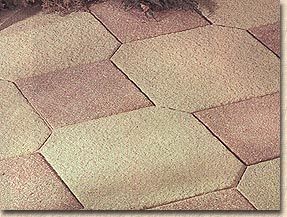
We find that dry sand/cement jointing usually has limited success with these types of flags if they are laid close-jointed with no mortar. Although it minimises the risk of staining, some clients prefer the more traditional mortar joints .
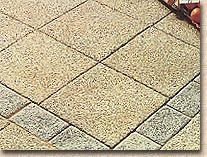

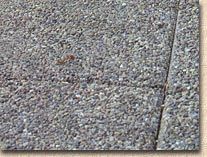
Decoratives includes all the other flags that don't fit into one of the above categories. There are flags mimicking cobbles, setts, old bricks and even wooden decking and railway sleepers, as well as flags making a pretty poor attempt to look like block paving, and some really atrocious stuff with leaves or cheesy wildlife images stamped into the surface, generally sold to the gullible via garden centres.

There is a vast range available, although some products are specific to local manufacturers, and the larger Builder's Merchants tend only to stock the products of the big, national manufacturers. Once again, it seems fair to say that you generally get what you pay for. Some will be soft 'fence post' concrete, while others are quality products. At the end of the day, it's a matter of personal taste. It is you that has to live with the chosen flag, not the contractor.

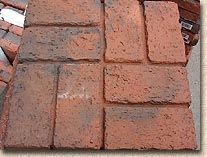
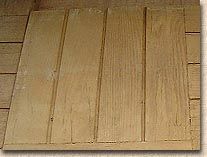
Sizes and Coverage
There is a massive range of sizes available. The commonest size for patio flags is 450x450x35mm, although smaller and larger examples are available, enabling complex or random-looking patterns to be created. There are also radial units, used to form circles and arcs, along with hexagons, trapezoids and umpteen other geometric shapes.
Some of the patio flags on the market are available in thicker sizes, 50 and 65/70mm thick units, which enables a chosen paving look to be extended beyond the garden/patio to driveway use. The typical 450x450x35mm flag, at around 20Kg, is more suited to handling by the home handyman, than the commonly available 50mm thick flags.
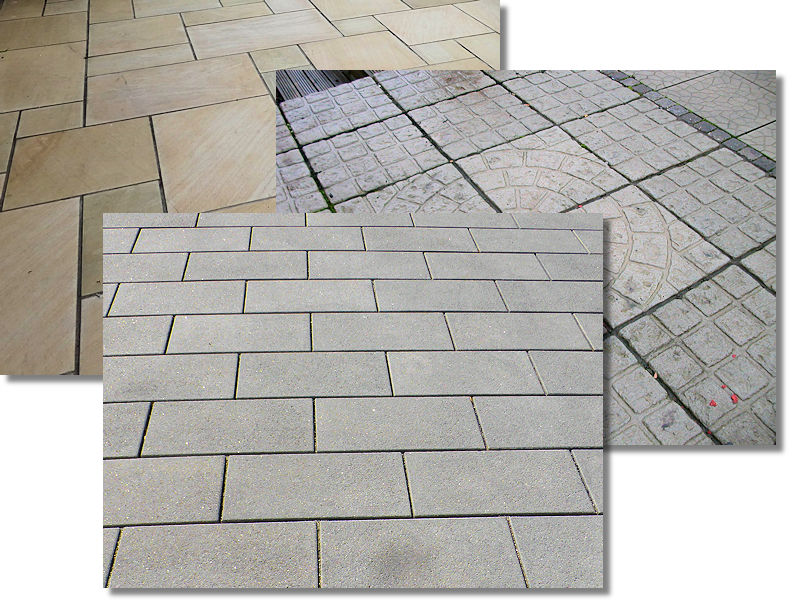
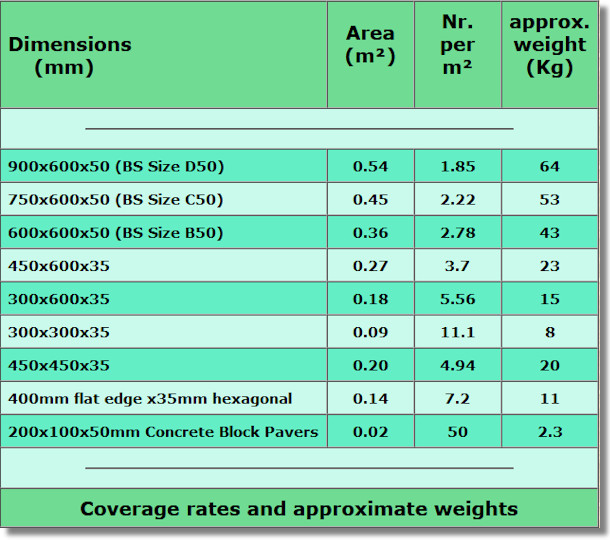
Patterns and Designs
There are many techniques to make these flags look even more glamorous. They can be combined with paving bricks to create borders or panels of contrast (see drawings) and they are available in a variety of colours, of which we find the reds and buffs to be the most useful, other colours tending to look wishy-washy after a few seasons out in the British or Irish climate.
The modular size of the flags and blocks allows almost infinite design possibilities, a few of which are shown below. Play around with graph paper or a CAD system to create a design that suits your application, or help yourself to one of our designs below, and tailor it to your needs.
450x450mm flags laid in a chequerboard pattern with, on the left a 200mm wide block paver edging, and on the right, a 100mm wide block paver edging.
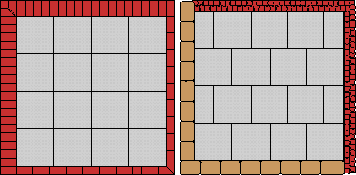
450x450mm flags laid in stretcher bond pattern with, on the left, a olde-worlde block paver edging, and on the right, a 160mm wide edging formed from 2 rows of 80x80mm clay cobbles.
450x450mm flags laid in a 3.0x3.0m chequerboard pattern with a 2.4m diameter circular feature.
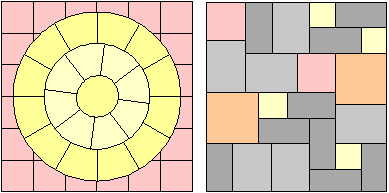
A random layout created from 5 different sizes of flags. This pattern looks best when used with riven-type paving.
Click here for other random patterns suitable for riven paving
Sweeps and curves created using radial sections, in a background panel of 400mm hexagons with floral motif
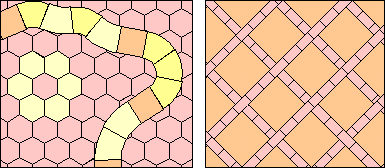
Diamond pattern created using 450x450mm flags with 100mm wide brick edging between each flag.
Maintenance
- Medium level maintenance required once laid. Sweep occasionally to remove dust and detritus.
- If you find green algae building up on them, it can be removed using bleach , or, we are told, by swilling the area with Jeyes' Fluid to kill the algae, which can then be swept away after a couple of days. This problem with algal build-up seems to particularly affect the coarse-textured type of flag. Using a pressure washer should be a last resort.
- Mortar pointing seems prone to cracking and vegetation; it can be cut out and re-pointed if required. Some of the flags available are better suited to dry jointing .
Pros and Cons
Vast range of prices, from very cheap to quite expensive. Large D-I-Y chains often sell 450x450mm flags for 99p including VAT, while the very best riven copies can cost £4-£6 for that size of flag.
Very easy to obtain as they are carried by most Builders Merchants. Most manufacturers publish free brochures detailing the range they supply. Ask your local builders merchant for a copy, or check out the Links page for details on the larger manufacturers and how to contact them. If you see a decorative flag at a garden centre, try to find the name of the flag and its manufacturer, and get a builders merchant to quote you a price - they are often up to 20% cheaper than garden centres!
Increasingly sold as Project or Patio Packs
Must be properly drained to gullies or other suitable drainage points.
Construction Diagram
